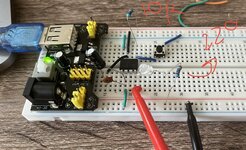R&DElec
Newbie level 5
Hello,
I am trying to program a PIC10F206 using pikit4+ MPLAB X IDE v6.05 and C8 compiler. I am super new in this field and I am facing a problem when I programmed the pic I only get 2.7 volt in my output pins. the program is super simple because I'm just trying to figure out why I am not receiving 5 volt at out put.
the pic is connected to 5v so pin2 is connected to 5v, pin 7 connected to ground, pin 8 connected to vdd MCLR(this was was suggested but it did not help), my pin 6 is GPO0 and is my input and pin 5 is my GPO1 my output and Pin4 GPO2 is my out put as well.
i also tried connecting an led and a 220 resistor at the outputss and then i used the multimeter to measure but nothing is helping
[ MODERATOR ACTION: Added 'C' Syntax tag ]
I am trying to program a PIC10F206 using pikit4+ MPLAB X IDE v6.05 and C8 compiler. I am super new in this field and I am facing a problem when I programmed the pic I only get 2.7 volt in my output pins. the program is super simple because I'm just trying to figure out why I am not receiving 5 volt at out put.
the pic is connected to 5v so pin2 is connected to 5v, pin 7 connected to ground, pin 8 connected to vdd MCLR(this was was suggested but it did not help), my pin 6 is GPO0 and is my input and pin 5 is my GPO1 my output and Pin4 GPO2 is my out put as well.
i also tried connecting an led and a 220 resistor at the outputss and then i used the multimeter to measure but nothing is helping
Code C - [expand]
[ MODERATOR ACTION: Added 'C' Syntax tag ]
Last edited by a moderator:
